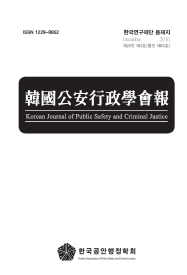본 논문은 경찰의 위법한 음주운전 단속의 결과로 무죄판결을 받는 사례가 적지 않다는 점에 착안하여, ① 음주운전 단속과 관련된 실정법규와 선행연구들을 살펴보고, ② 이론적 논의와 더불어 경찰관의 음주측정 요구 요건과 음주측정불응죄 성부에 관한 최근 판례를 심층적으로 분석하며, ③ 주요쟁점을 도출하고 논평하고, ④ 음주단속 실무자를 위한 법리적 제언을 도모하고자 기획되었다. 경찰의 음주운전 단속을 둘러싸고 있는 법적 쟁점은 ① 음주운전 단속의 법적 성격, ② 음주운전 단속과정에서 활용되는 임의동행의 요건, ③ 현행범인 체포의 요건, ④ 보호조치의 적법 요건, ⑤ 약물(마약)운전죄와 위험운전치사상죄의 특징, ⑥ 「교통단속 처리지침」의 법규성 여부로 각각 도출하고 논평을 전개하였고, 이를 토대로 아래와 같이 단속 실무자를 위한 제언을 정리하였다. 첫째, 경찰권발동의 목적과 근거를 명확하게 이해하고 법집행이 적법하게 이행될 수 있도록 노력해야 한다. 경찰의 음주운전 단속은 예방적 행정경찰작용과 범죄수사활동의 연속선상에 놓여 있다. 따라서 음주단속의 목적이 예방적 행정경찰권 발동이라면 「경찰관 직무집행법」을 우선적으로 적용해야만 하고, 이에 반하여 사법경찰권 행사라면 「형사소송법」을 엄격하게 준수해야만 한다. 둘째, 음주운전 단속과정에서 임의동행을 활용하기 위해서는 ⓛ 명확하게 동행을 거부할 수 있다는 사실을 고지하여야 하고, ② 자유롭게 이탈 및 퇴거할 가능성을 보장하여야만 하며, ③ 이러한 과정들이 객관적인 사정에 의하여 명백하게 입증되어야 한다. 셋째, 음주운전 단속과정에서 현행범인으로 체포하기 위해서는 ⓛ 행위의 가벌성, ② 범죄의 현행성과 시간적 접착성, ③ 범인·범죄의 명확성, ④ 체포의 필요성(도망 또는 증거인멸의 염려)을 모두 충족하여야 한다. 넷째, 피구호자에 대한 음주측정요구가 적법하기 위해서는 보호조치의 법적 요건을 엄격하게 준수하여야 한다. 다섯째, 주취운전죄는 혈중알코올농도 0.03% 이상인 상태에서 자동차 등을 운전하면 곧바로 성립하지만, 약물(마약)운전죄는 약물 투약 사실만으로 바로 유죄가 인정되는 것이 아니라, ‘약물의 영향으로 정상적으로 운전하지 못할 우려가 있는 상태’가 합리적 의심 없이 증명되어야만 하고, 위험운전치사상죄는 형식적으로 혈중알코올농도의 법정 최저기준치를 초과하였는지 여부와는 상관없이 운전자가 ‘음주의 영향으로 실제 정상적인 운전이 곤란한 상태’에 있어야만 한다. 여섯째, 「교통단속 처리지침」은 「도로교통법」과 「도로교통법 시행규칙」의 위임에 따라 행정규칙의 형식으로 그 법령의 내용이 될 사항을 구체적으로 정하고 있기 때문에 법규성을 지닌다고 이해해야 한다.
This paper is motivated by the fact that a significant number of acquittals arise from unlawful DUI enforcement by the police. It is structured as follows: ① A review of the relevant statutory framework and prior studies on DUI enforcement; ② An indepth analysisboth theoretical and caselaw basedof the requirements for police sobrietytest requests and the elements of the offense of refusing such tests; ③ The identification and commentary on the major legal issues; ④ The formulation of legal recommendations for practitioners involved in DUI enforcement. Based on our findings, we offer the following recommendations for DUI enforcement practitioners: 1. Clarify the purpose and legal basis for invoking police authority. If the stop is intended as a preventive administrative measure, the Police Duties Execution Act must be applied; if it is a criminal investigation, the Criminal Procedure Act must be scrupulously followed. 2. Ensure true “voluntary accompaniment.” To rely on voluntary accompaniment, officers must (i) clearly inform the driver that they may refuse to accompany, (ii) guarantee the driver’s ability to leave or withdraw at will, and (iii) document these advisals and opportunities with objective evidence. 3. Meet all elements for a lawful on-the-spot arrest. An arrest of a DUI suspect without warrant must satisfy four criteria: (i) the act is punishable, (ii) the offense is ongoing and temporally connected to the arrest, (iii) the suspect and offense are clearly identified, and (iv) there is a necessity for arrest (risk of flight or evidence destruction). 4. Strictly observe protective-custody requirements before requesting a sobriety test. 5. Differentiate per se DUI, drug-impaired driving, and crime of homicide and injury by dangerous driving. 6. Treat the Traffic Enforcement Guidelines as binding.
Ⅰ. 문제제기
Ⅱ. 연구의 이론적 토대
Ⅲ. 주요 쟁점과 논평
Ⅳ. 단속 실무자를 위한 제언
Ⅴ. 결론
참고문헌
(0)
(0)
